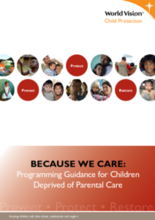World Vision prioritises the well-being of the world’s most vulnerable children (World Vision International’s Integrated Focus). Children without parental care have been deprived of the protection and guidance normally given by their parents as primary caregivers and duty-bearers, leaving them vulnerable to abuse, neglect and exploitation. These children may be found living on the streets, struggling to care for their siblings, trafficked and exploited for sex or labour, or languishing in large, impersonal institutions. World Vision’s commitment to the most vulnerable children requires significant investment in determining appropriate responses to these difficult situations. Therefore, the aim of this paper is to prompt discussion and discernment regarding best practices for models of care for children deprived of parental care (CDOPC).
This paper sets forward the following general recommendations for consideration by World Vision and other relevant agencies:
Community and family-based practices in alternative care models must be pursued, rather than institutional practices;
Any placement of children in alternative care must be based upon the best interests of the child;
A hierarchy of models is productive as a starting point for discussion and planning, but requires discernment in application based on the specific context and situation of each child;
The benefits and concerns of each model should be considered when deciding on a model of alternative care, and with every model measures must be taken to counter concerns with appropriate programming practices.
These general recommendations are explained and expanded upon in the two main sections of the paper: (1) general alternative care principles, and (2) analysis of alternative care models. Section 1 includes principles and guidelines that can and should be applied to all alternative care interventions. These principles are divided into seven categories: developing foundations for alternative care, strengthening families, strengthening communities, engaging government, empowering children, supporting caregivers and developing professional practices.
Section 2 then analyses five models of alternative care in more detail: kinship care, foster care, children living independently, group homes and children’s villages. Each section includes a list of benefits and concerns, programming suggestions for implementation and case studies to aid reflection on practical application. Section 2 has a modular structure. Each of the five models developed in this section can be read by itself, independent of the others, for those interested in only one or a few of the models. Therefore, there is repetition of important principles among models. Throughout the paper specific sections are identified as ‘hot topics’ for the purpose of encouraging discussion on a topic that is debated among sources.
©World Vision International

